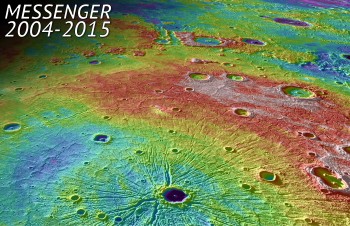Sean Solomon: Messenger Finds Ingredients for Life on Mercury
November 2, 2015

Mercury, the closest planet to the sun, was long thought to be a blazing, desiccated world containing not much more than an iron core surrounded by a thin, silicate crust.
Sean Solomon, director of the Lamont-Doherty Earth Observatory of Columbia University, an Edwin Allday Lecturer, and principal investigator for NASA’s MESSENGER mission, challenged that perspective in a February 2015 talk at the Jackson School that presented findings from MESSENGER, a Mercury probe.
Instead of a bleak iron world, Solomon said MESSENGER showed that the surface of Mercury contained volatile elements, as well as traces of carbon and frozen water that were delivered by comets. They are findings that could shed light on the origins of life on our planet.
“We’re left with the intriguing notion that there is a record on the planet closest to the sun, on the planet with the largest range of diurnal temperatures, of the delivery to the early solar system of H2O and some of the building blocks of life,” said Solomon.
It’s unlikely life exists or ever existed on Mercury, Solomon said; there’s no evidence that water was ever in its liquid state. But finding that comets with carbon and water made it to Mercury helps support the idea that life on Earth was seeded by comet material billions of years ago. A sample of what that material contained is on Mercury right now, Solomon said.
“If we think that these building blocks delivered to Earth and possibly other bodies were factors in the origin and evolution of early life on our planet, there’s a place we can go in the solar system — not the place we thought of — where there’s a witness…to at least the recent delivery of these compounds to the solar system,” Solomon said.

Lamont-Doherty Earth Observatory.
These insights were made possible because of readings taken by MESSENGER, a spacecraft launched in 2004 to orbit and study Mercury. Solomon began his talk explaining the engineering challenges that scientists faced while building the probe, such as guiding it into Mercury’s orbit and protecting its electronics from the extreme heat. The remainder of his talk focused on explaining how data collected by MESSENGER challenged prior assumptions scientists had about Mercury’s environment.
Before MESSENGER, scientists thought that Mercury’s volatiles would have evaporated during the planet’s formation due to high temperatures caused by a large asteroid impact or the sun’s rays, Solomon said. But data from the probe’s X-ray and gamma ray spectrometers told a different story: Mercury’s surface contained ten times the amount of sulfur as Earth; about the same amount of potassium as the Earth; and about the same amount of chlorine as Mars.
“These volatile elements are much more abundant than predicted by any of the formation models prior to our mission that call for extended periods of high temperatures,” Solomon said. “So the formation of Mercury, and by implication the formation simultaneously of all the inner planets, is being rethought.”
In addition to chemical analysis, the MESSENGER probe provided pictures of Mercury’s surface. These pictures showed evidence for past volcanic eruptions on Mercury, including lava flows and pyroclastic deposits. They also gave scientists a closer look inside the planet’s many impact craters, Solomon said, mentioning the discovery of depressions inside craters called “hollows.” Analysis by MESSENGER instruments indicated that they were formed when underground volatiles, brought close to the surface by the force of an impact, evaporated into space.
It was also inside craters where MESSENGER found water in the form of ice, Solomon said. Since Mercury’s axis of rotation has no tilt, parts of the poles have been void of direct sunlight for billons of years, making them a much cooler environment than most other regions of the planet. Observatories on Earth first detected the ice as “bright spots” on radar readings. Instruments on MESSENGER confirmed the radar data, while finding that the ice was covered by an insulating layer of carbonaceous material about 20-30 centimeters deep.
At the time of the talk, MESSENGER was about two months away from running out of fuel. Solomon ended his presentation by assuring the audience that the probe would continue to do science until the end.
“This mission only has two months to go, but it will be a very interesting two months where we are making chemical measurements, taking pictures, making other measurements…at a closer range than ever before,” Solomon said. “Stay tuned.”
MESSENGER met its end on April 30, 2015, when it crashed into Mercury’s surface.
— Monica Kortsha
Back to the Newsletter
